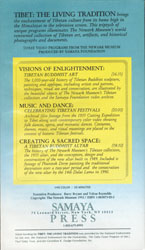St. Gregory College Preparatory School
3231 N. Craycroft
Tucson, AZ 85712
(520) 327-6395
Videos about Tibet
Geographical Odysseys
This video is actually three in one, and each part is excellent. They all use the extensive collection of Tibetan art at the Newark Museum in Newark, New Jersey. The first part is a wonderful introduction to the types of Tibetan Buddhist art including style, purpose, and artistic intent. The second part is most fascinating combining as it does rare archival footage from the first half of the twentieth century of Tibetan music and dance and more recent revivals of some of the same artistic traditons. The third part explains in detail how the Newark Museum built a Tibetan Buddhist altar, how it was dismantled, and then rebuilt and consecrated by the Dalai Lama.
Visions of Enlightenment
Part I: Tibetan Buddhist Art
Content questions:
1. What are three media in which Tibetan Buddhist art is done?
2. What are sources for the Tibetan art in the Newark Museum?
3. By the eleventh century what tradition most influenced Tibetan art?
4. Name several of the subjects of Tibetan art?
5. Given that all Tibetan art is religious in nature, what are some of its purposes?
6. Explain several of the materials for sculpture?
7. What is a tangka and for what was it used?
8. What must happen to all art once it is finished?
9. What kind of things were put in the Newark Museum’s Sakyamuni statue and why?
Discussion questions:
1. Explain the overwhelming importance of religion in all Tibetan art and discuss
how this would affect the aesthetic ideals of the artist?
2. Why are the media used by Tibetan artists limiting in their possibilities; yet, how
have they maximized and adumbrated their artistic possibilities?
3. Why is art so important to religion?
4. In Buddhism the body, speech, and mind are important. Explain what these mean
in Buddhist theology. What are the equivalents in other religions?
Part II: Music and Drama
Content questions:
1. What are the four main festivals in the Tibetan Buddhist calendar?
2. What has happened in Tibet since the Chinese took over?
3. Which of the festivals is most important and why?
4. What is the role of masks in these dramas?
5. In the Opera Festival, what is the role of the demons, and how does the festival end?
6. Where are the New Year Festivals usually held?
Discussion questions:
1. Observe the women’s hair, headdresses, and clothes.
2. What are observable differences between archival and recent videos?
3. Discuss the instruments used and what tonal effects they produce?
4. What is overall intention of the dance and drama of Tibetan people?
5. What issues have affected the changes in Tibetan art and will this have a negative or positive effect on future Tibetans within Tibet or outside?
Part III: Creating a Sacred Space
Content questions:
1. What is the importance of an altar in Tibetan Buddhism?
2. Who contributed most of the art to the Newark Museum?
3. When and how and by whom was the first altar build in Newark?
4. Why, in 1988, did the altar need to be deconsecrated and how and by whom was this done?
5. What is the significance of om mani padme um?
6. Who is Avalikiteshvara?
7. List the major elements of the altar? Explain which of these elements appeal to the senses.
8. Vocabulary: chorten, dorgee, chakra, mandala, tangka, lotus, vraja
.Discussion questions:
1. Why should museums collect religious art?
2. What are ethical issues involved in the collection of such art especially if it is taken from sacred spaces or if its provenance (the location and legality of its finding) is not known?
3. Should museums be required to return illegally gotten art?
4. How has the Newark Museum dealt with these questions?
5. What impact would the visit of the Dalai Lama have on the museum and the city and people of Newark?
6. What are other examples of religious and sacred art in museums?
Website Link: http://www.newarkmuseum.org/
This site was created by Robert C. Mossman at the NEH Summer Institute "Cultures and Religions of the Himalayan Region," held at the College of the Holy Cross, Summer 2004

